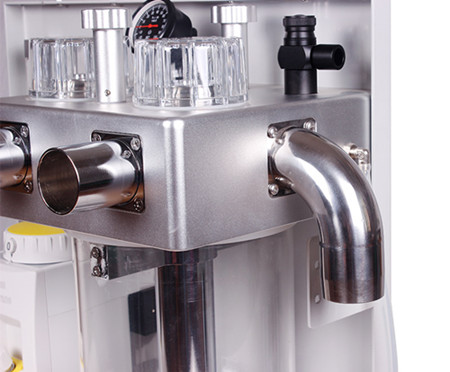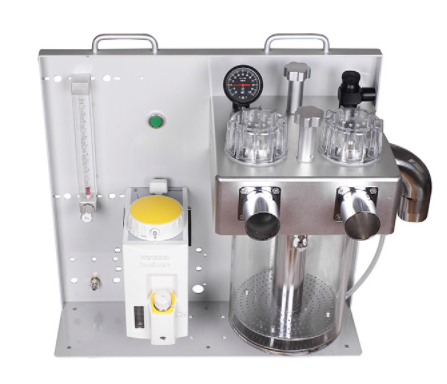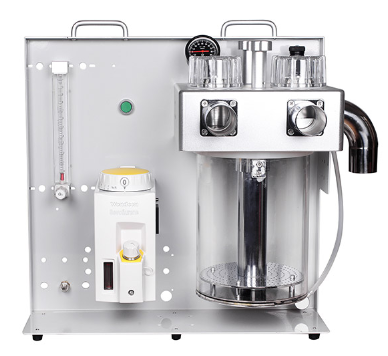How to Use Veterinary Anesthesia Machine
Jul. 25, 2022
The veterinary anesthesia machine evaporates the liquid anesthetic into a gaseous state and delivers it to the lungs of the animal. Through the blood into the circulatory system, to achieve the purpose of anesthesia. It also replenishes oxygen and increases the oxygen content in the animal's body to ensure animal safety.
Machine preparation before surgery
1. Prepare sufficient gas source;
2. Ensure that all parts of the veterinary anesthesia machine are properly installed and adjusted sensitively;
3. Prepare suitable accessories: laryngoscope, tracheal cannula, double-branch circuit tube, airbag, sodium lime, anesthetic drugs, etc;
>>Wholesale parts of anesthesia machine veterinary here at reasonable prices
4. Check the gas tightness of the veterinary anesthesia machine by connecting all the pipelines correctly;
5. Ensure that the veterinary anesthesia machine is well gas-tight, and if air leakage points are found, check and replace them in time.
Steps of using an anesthesia machine
1. APL valve fully open
①Advantages.
Timely pressure relief to prevent the animal's lungs from being subjected to excessive pressure.
②Disadvantages.
Some isoflurane and oxygen are wasted. Isoflurane will pollute the air (need to connect the exhaust gas absorption device).
2. Main valve open
Open the main valve of the oxygen cylinder of the veterinary anesthesia machine. Adjust the output pressure to 0.2~0.3MPa, do not exceed 0.4MPa.
①The pressure is too large, very easy to collapse the tube.
②The pressure is too small, the gas volume is not enough to meet the needs of the animal.
3. Transition phase
The "3-3-3" principle is recommended to enable the animal to transition quickly and smoothly from the induction to the maintenance phase of anesthesia.
①The first 3 minutes after intubation.
②Oxygen flow rate should be adjusted to 3L/min (independent of animal size and species).
③Anesthesia concentration is adjusted to scale "3" (independent of animal size, species, etc.).
4. Maintenance anesthesia stage
①Start from the 4th minute.
②Adjust the oxygen flow meter: 100-150mL/Kg/min according to the weight of the animal.
③Adjust the anesthetic concentration: it is related to the animal's weight, physiological and pathological state, sensitivity to anesthetics and the length of surgery. Flexible adjustment according to the specific situation.
④ Monitoring during the operation is extremely important: respiration, heart rate, blood oxygen, etc.
5. Monitoring of airway pressure gauge
During the operation, make sure the veterinary anesthesia machine has the correct airway pressure to avoid affecting lung function or complications.
6. Withdraw the machine after the surgery
①Turn off the anesthesia tank first. It is also optional to turn off the veterinary anesthesia machine earlier during skin suturing (which helps to accelerate the animal's awakening).
②Let the animal inhales pure oxygen (more or less some anesthetic gas will remain in the line) and waits for awakening.
③When the animal starts to appear conscious, remove the tracheal intubation and withdraw the anesthesia machine from the animal.
④Remember not to adjust the oxygen flow meter to the minimum first after withdrawing the machine (because all the pressure is stored between the flow meter and the anesthesia tank when the oxygen master valve is not closed, and it is easy to collapse the tube). First, close the oxygen cylinder valve, press the quick oxygen valve to discharge the remaining gas, so that the oxygen pressure gauge and output pressure gauge pointer to zero. Then turn off the gas circuit switch and finish.
Selection of anesthetic drugs for veterinary anesthesia machine
When using anesthesia in veterinary anesthesia machines, there are many kinds of drugs that can be injected intravenously, intraperitoneally, or intramuscularly to produce general anesthesia. The following are easy to use, economical and safe, the most widely used several.
1. Chloral hydrate: It is a sedative-hypnotic drug and can be used for intravenous anesthesia. But it has a large YZ breathing and myocardial contraction and other side effects. With magnesium sulfate, sodium pentobarbital, and alcohol compound use can significantly reduce side effects and improve safety and security.
2. Barbiturates: including sodium pentobarbital, sodium phenobarbital, sodium phenobarbital, etc. These drugs can be injected intravenously or intraperitoneally alone, and can also be used in combination with other anesthetic drugs to reduce the side effects of various drugs when used alone.
3. Chemically pure alcohol: intravenous injection can produce general anesthesia, but the effect of anesthesia is weak, and the dose required to put the dog to sleep is large and long, and the time required to enter the period of general paralysis from sleep is short and not easy to control, so it is not very safe to use alone and is generally used in combination with other anesthetic drugs. It is rarely used in clinical practice.
4. "846" combination: also known as quick sleep new, by several sedatives and anesthetics mixed, containing Pauldinin, haloperidol, and other components, is a kind of anesthesia compound preparation with a wide range of safety. It has sexual analgesia, sedation, and muscle relaxation effects. The satisfactory anesthetic effect can be achieved by intramuscular, intraperitoneal, or intravenous injection alone.
The use of a veterinary anesthesia machine
Since the weight of animals is much smaller than that of humans, special veterinary anesthesia machines are generally used.
The role of veterinary anesthesia machines is.
1. Can accurately control the depth of anesthesia of animals, can effectively protect the safety of experimental animals;
2. Good anesthetic effect, strong analgesic effect, can be long time maintenance of anesthesia;
3. The animal wakes up quickly after stopping anesthesia, which is convenient for the next experiments;
4. Small side effects, little adverse effect on heart and lungs, no effect on liver and kidney, no allergic reaction;
5. In case of emergency, it is convenient for rescue;
6. It can keep the airway unobstructed and the oxygen supply adequate.
Maintenance of veterinary anesthesia machine
At Wondcon, we know that a well-maintained veterinary anesthesia machine is essential for safe practice. It is our pleasure to share with you some technical advice that will extend the lifespan of your equipment.
A well-maintained device will reduce gas consumption as well as the level of pollution in the room.
Prerequisites : Oxygen supply : 40 to 60 psi (2.8 to 4.2 bar), patient circuit, and bag.
Note: Repeat the following maintenance procedure for your 2 circuits (Bain & absorber).
Step 1
Connect the circuit to be verified to the fresh gas outlet of the veterinary anesthesia machine.
Step 2
Close the patient's circuit outlet with a plug or your thumb.
Step 3
Open the flowmeter to approximately 200 ml.
Step 4
Close the gas evacuation valve.
Step 5
Depress the oxygen flush button and hold until the pressure on the manometer indicates approximately 30 cm H2O.
Step 6
Check the manometer. The pressure must not drop (but it can increase). If the pressure drops, replace the patient circuit and the bag and try again.
Step 7
Open the evacuation valve before using the veterinary anesthesia machine again.
If you encounter an excessive leak, it is recommended that you proceed by elimination to find the source of the problem by replacing a single component at a time. The most frequent leaks can be found at the fresh gas outlet o-ring, the patient circuit, and the bag.
Once the leak identified, dispose of the defective item to avoid it is being reused by error.
At the end of each day, it is recommended that you close the oxygen tank and fill up the anesthetic agent vaporizer.
We are a Veterinary Anesthesia Machine supplier, and also supply various parts of veterinary anesthesia machine, please feel free to contact us if you need them!









